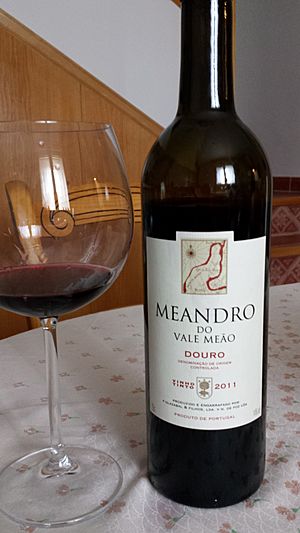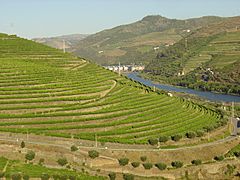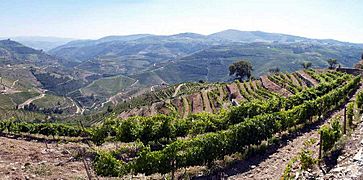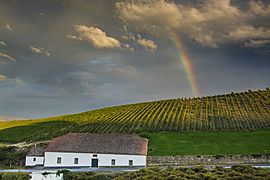Douro DOC facts for kids
| UNESCO World Heritage Site | |
|---|---|

Vineyards in Alto Douro
|
|
| Location | Trás-os-Montes e Alto Douro Province, Portugal |
| Criteria | Cultural: (iii)(iv)(v) |
| Inscription | 2001 (25th Session) |
| Area | 24,600 ha (61,000 acres) |
| Buffer zone | 225,400 ha (557,000 acres) |
Douro is a Portuguese wine region centered on the Douro River in the Trás-os-Montes e Alto Douro region. It is sometimes referred to as the Alto Douro (upper Douro), as it is located some distance upstream from Porto, sheltered by mountain ranges from coastal influence. The region has Portugal's highest wine classification as a Denominação de Origem Controlada (DOC) and is registered as a Protected Designation of Origin under EU and UK law, and as a Geographical Indication in several other countries through bilateral agreements. While the region is best known for Port wine production, the Douro produces just as much table wine (non-fortified wines) as it does fortified wine. The non-fortified wines are typically referred to as "Douro wines".
Alto Douro was one of the 13 regions of continental Portugal identified by geographer Amorim Girão, in a study published between 1927 and 1930. Together with Trás-os-Montes it became Trás-os-Montes e Alto Douro Province.
The style of wines produced in the Douro range from light, Bordeaux-style claret to rich Burgundian-style wines aged in new oak.
Contents
Geography and climate
The Douro wine region is situated around the Douro river valley and lower vallies of its tributaries Varosa, Corgo, Távora, Torto, and Pinhão. The region is sheltered from Atlantic winds by the Marão and Montemuro mountains and has a continental climate, with hot and dry summers and cold winters.
It is usually subdivided into three subregions, from the west to the east:
- Baixo Corgo ("below Corgo"), a subregion with the mildest climate and most precipitation. It has 14,000 hectares (35,000 acres) of vineyards. Although it is the subregion which was planted first, in general, it is considered to give wines of lesser quality than the other two subregions.
- Cima Corgo ("above Corgo") is the largest subregion with 19,000 hectares (47,000 acres) of vineyards, centered on the village of Pinhão, and where the majority of the famous Quintas are located.
- Douro Superior ("upper Douro") is the hottest and driest of the subregions, and stretches all the way to the Spanish border. It has 8,700 hectares (21,000 acres) of vineyards and is the source of many wines of very good quality. As it is the least accessible of the three subregions, it is the most recently planted, and it is still expanding.
Terraced vineyards are very common in the Douro region. Vineyards dedicated to Port production are usually planted on schist while areas with granite-based soils are used for table wine production.
The Douro winemaking region was declared a World Heritage Site in 2001.
Grapes
The principal grape varieties of the Douro region include the black grapes Bastardo, Mourisco tinto, Tinta Amarela, Tinta Barroca, Tinta Cão, Tinta Roriz (the same as Spain's Tempranillo), Touriga Francesa and Touriga Nacional, and the white grapes Donzelinho branco, Gouveio, Malvasia Fina, Rabigato, and Viosinho.
A large number of grape varieties are grown in the Douro region, most of them local Portuguese grapes. For a long time, the grape varieties grown in the Douro were not very well studied. Vineyards of mixed plantation were the norm, and most of the time, the vineyard owners didn't know which grape varieties they were growing. A pioneering effort were made in the 1970s which identified Touriga Nacional, Tinta Roriz, Touriga Franca, Tinta Cão and Tinta Barroca as the prime dark-skinned grape varieties. Tinta Amarela and the teinturier Sousão has later come to be included among the varieties that attract the most interest. This work was important for creating the new wave of top Douro wines and has also led to a greater focus on the grape varieties that go into Port wine. Most top quintas now replant with single-variety vineyards and focus on a limited number of varieties, but older, mixed vineyards will remain in production for many decades to come.
Gallery
de:Alto Douro nl:Alto Douro ja:アルト・ドウロ・ワイン生産地域 pl:Alto Douro pt:Região Vinhateira do Alto Douro ro:Douro DOC fi:Alto Douro
See also
 In Spanish: Douro (vino) para niños
In Spanish: Douro (vino) para niños











